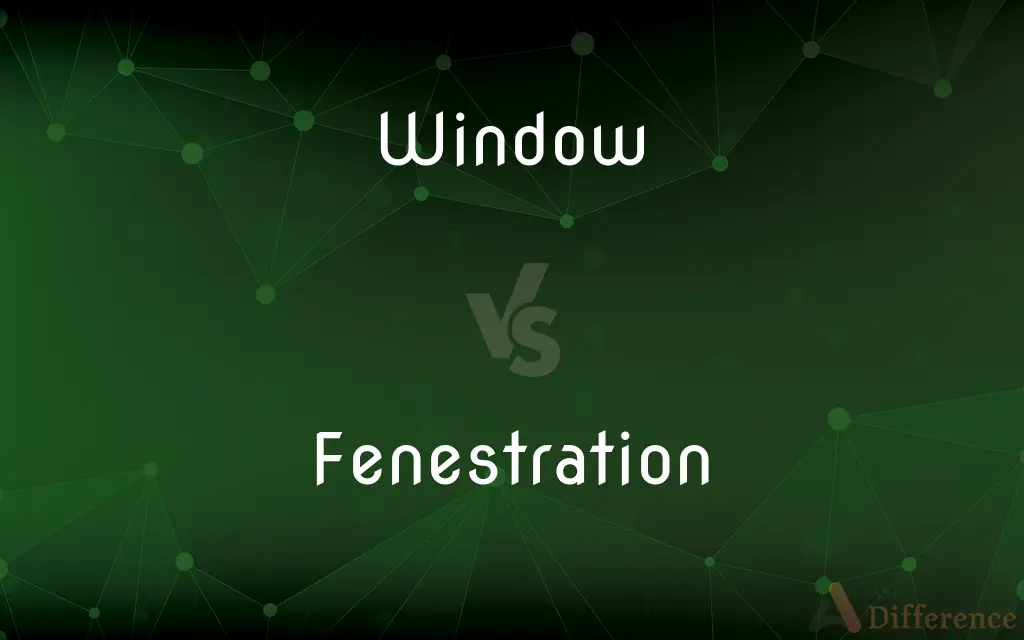Window vs. Fenestration — What's the Difference?
By Maham Liaqat & Urooj Arif — Updated on April 27, 2024
Window refers to an opening in a wall for light and air, fitted with glass, while fenestration denotes the design and arrangement of all openings like windows and doors in a building.

Difference Between Window and Fenestration
Table of Contents
ADVERTISEMENT
Key Differences
A window is a specific architectural feature, typically an opening in a building's wall that is fitted with glass or a transparent material, used to let light and air inside while providing a view outside. Fenestration, on the other hand, is a broader term that refers to the design, construction, and presence of any openings in a building, including windows, doors, and skylights.
Windows are designed for functionality and aesthetics, providing not only visibility and light but also ventilation. Fenestration considers these aspects but on a larger scale, focusing on the placement and overall integration of various types of openings within the architectural design to achieve a functional and visually appealing building envelope.
While windows are a common component of fenestration, fenestration itself encompasses a wider range of elements and considerations. This includes the thermal performance of openings, their impact on energy efficiency, and how they contribute to the building’s overall environmental control features. Fenestration is critical in architectural design for balancing indoor light, controlling heat gain or loss, and enhancing the aesthetic harmony of the building facade.
The term window can be used to describe any regular or ornamental glassed opening in a structure that is intended to be opened, whereas fenestration may also include fixed installations that do not open but are integral to a building's design. Fenestration's role extends beyond functionality to include the impact of these openings on the building's overall energy consumption and environmental interaction.
Understanding the distinction between windows and fenestration is essential for architects and builders who are working to optimize building designs for both energy efficiency and aesthetics. While all windows are part of fenestration, not all fenestration is made up of windows—it may also include other design elements that contribute to a building's interaction with its surroundings.
ADVERTISEMENT
Comparison Chart
XDefinition
An opening in a building typically covered with glass
The arrangement and design of all openings in a building, including windows, doors, and skylights
Purpose
To provide light, air, and visibility
To integrate various openings for optimal design, light management, and energy efficiency
Components
Glass or other transparent material, frames
Windows, doors, louvers, vents, wall panels
Architectural Role
Part of the building’s exterior that allows for external viewing and ventilation
Comprehensive approach to the building’s envelope and its environmental interactions
Focus
Specific installation for visibility and ventilation
Overall building design and performance concerning all openings
Compare with Definitions
Window
An opening in the wall of a building fitted with glass.
She opened the window to let in fresh air.
Fenestration
Design aspect involving all openings in a building’s envelope.
Effective fenestration can greatly improve a building's energy efficiency.
Window
Transparent part of a building for viewing outside.
The large bay window offered a spectacular view of the lake.
Fenestration
Architectural term for the placement of openings.
Fenestration styles vary significantly between architectural periods.
Window
Functional decor in architectural design.
The stained glass windows added color and character to the church.
Fenestration
Consideration of the building's interface with the environment.
They redesigned the fenestration to enhance thermal performance.
Window
Structural element that provides light and air.
The room was bright and airy thanks to its tall windows.
Fenestration
Inclusive of elements like skylights and louvers.
The fenestration plan included several strategically placed skylights.
Window
Opening mechanism in a structure.
He double-checked all the windows were locked before leaving the house.
Fenestration
The arrangement of windows and doors in a building.
The architect focused on fenestration to maximize natural light.
Window
A window is an opening in a wall, door, roof, or vehicle that allows the passage of light and may also allow the passage of sound and sometimes air. Modern windows are usually glazed or covered in some other transparent or translucent material, a sash set in a frame in the opening; the sash and frame are also referred to as a window.
Fenestration
The design and placement of windows in a building.
Window
An opening constructed in a wall, door, or roof that functions to admit light or air to an enclosure and is often framed and spanned with glass mounted to permit opening and closing.
Fenestration
An opening in the surface of a structure, as in a membrane.
Window
A framework enclosing a pane of glass for such an opening; a sash.
Fenestration
The surgical creation of an artificial opening in a bone, as in the inner ear so as to improve or restore hearing.
Window
A pane of glass or similar material enclosed in such a framework
The ball broke the window.
Fenestration
(architecture) The arrangement of windows and similar openings in a building.
Window
An opening or transparent part that resembles a window in function or appearance
A sail window.
Fenestration
An opening in the surface of an organ etc; the surgical creation of such an opening, especially one in the bony part of the inner ear made to improve hearing.
Window
The transparent panel on a window envelope.
Fenestration
An opening that occurs naturally or is created surgically, as through a biological membrane.
Window
The area or space immediately behind a window, especially at the front of a shop
Goods displayed in the window.
Fenestration
(botany) Either a translucent area in a structure such as a leaf or flower petal, or an opening in a structure.
Window
A means of access or observation
St. Petersburg was Peter the Great's window onto the Baltic.
Fenestration
(nautical) The practice of placing holes in the rudder of a ship to reduce the work required to move the rudder while preserving its ability to steer the ship.
Window
An interval of time during which an activity can or must take place
A window of opportunity for a space mission.
A window of vulnerability when the air force was subject to attack.
Fenestration
The arrangement and proportioning of windows; - used by modern writers for the decorating of an architectural composition by means of the window (and door) openings, their ornaments, and proportions.
Window
Strips of foil dropped from an aircraft to confuse enemy radar; chaff.
Fenestration
The state or condition of being fenestrated.
Window
A range of electromagnetic frequencies that pass unobstructed through a planetary atmosphere.
Fenestration
The arrangement of windows in a building
Window
(Computers) A rectangular area on a screen in which a document, database, or application can be viewed independently of the other such areas.
Fenestration
Surgical procedure that creates a new fenestra to the cochlea in order to restore hearing lost because of osteosclerosis
Window
A launch window.
Window
An area at the outer limits of the earth's atmosphere through which a spacecraft must pass in order to return safely.
Window
An opening, usually covered by one or more panes of clear glass, to allow light and air from outside to enter a building or vehicle.
Window
An opening, usually covered by glass, in a shop which allows people to view the shop and its products from outside; a shop window.
Window
(architecture) The shutter, casement, sash with its fittings, or other framework, which closes a window opening.
Window
A period of time when something is available or possible; a limited opportunity.
Launch window;
Window of opportunity;
You have a two-hour window of clear weather to finish working on the lawn.
Window
Something that allows one to see through or into something
His journal provides a window into his otherwise obscure life.
Window
A restricted range.
Window
(graphical user interface) A rectangular area on a computer terminal or screen containing some kind of user interface, displaying the output of and allowing input for one of a number of simultaneously running computer processes.
Window
A figure formed of lines crossing each other.
Window
(medicine) The time between first infection and detectability.
Window
Synonym of chaff
Window
(signal processing) A function multiplied with a signal to reduce spectral leakage when performing a Fourier transform.
Window
(transitive) To furnish with windows.
Window
(transitive) To place at or in a window.
Window
To apply a window function to (a signal).
Window
An opening in the wall of a building for the admission of light and air, usually closed by casements or sashes containing some transparent material, as glass, and capable of being opened and shut at pleasure.
I leaped from the window of the citadel.
Then to come, in spite of sorrow,And at my window bid good morrow.
Window
The shutter, casement, sash with its fittings, or other framework, which closes a window opening.
Window
A figure formed of lines crossing each other.
Till he has windows on his bread and butter.
Window
A period of time in which some activity may be uniquely possible, more easily accomplished, or more likely to succeed; as, a launch window for a mission to Mars.
Window
A region on a computer display screen which represents a separate computational process, controlled more or less independently from the remaining part of the screen, and having widely varying functions, from simply displaying information to comprising a separate conceptual screen in which output can be visualized, input can be controlled, program dialogs may be accomplished, and a program may be controlled independently of any other processes occurring in the computer. The window may have a fixed location and size, or (as in modern Graphical User Interfaces) may have its size and location on the screen under the control of the operator.
Window
To furnish with windows.
Window
To place at or in a window.
Wouldst thou be windowed in great Rome and seeThy master thus with pleach'd arms, bending downHis corrigible neck?
Window
A framework of wood or metal that contains a glass windowpane and is built into a wall or roof to admit light or air
Window
A transparent opening in a vehicle that allow vision out of the sides or back; usually is capable of being opened
Window
A transparent panel (as of an envelope) inserted in an otherwise opaque material
Window
An opening that resembles a window in appearance or function;
He could see them through a window in the trees
Window
The time period that is considered best for starting or finishing something;
The expanded window will give us time to catch the thieves
They had a window of less than an hour when an attack would have succeeded
Window
A pane in a window;
The ball shattered the window
Window
An opening in the wall of a building (usually to admit light and air);
He stuck his head in the window
Window
(computer science) a rectangular part of a computer screen that contains a display different from the rest of the screen
Common Curiosities
What factors are considered in the fenestration design of a building?
Factors in fenestration design include the orientation and size of openings, the type of glazing, the thermal properties of materials, and the aesthetic relationship between the building's interior and exterior.
How do different types of windows contribute to a building's architecture?
Different types of windows, such as bay, casement, or sliding windows, contribute to architectural style, functionality, and the building's overall energy performance by affecting light entry and air circulation.
What is the primary function of a window?
The primary function of a window is to provide light, air, and visibility to the interiors of a building.
How does fenestration impact a building’s energy efficiency?
Fenestration affects a building's energy efficiency through the management of light and heat transfer, contributing to thermal comfort and reduced energy consumption.
Why is proper window placement important in building design?
Proper window placement is crucial for optimizing natural light, enhancing views, improving ventilation, and maintaining energy efficiency, all of which affect occupant comfort and utility costs.
What are the environmental benefits of thoughtful fenestration?
Thoughtful fenestration maximizes natural light, improves air quality, reduces reliance on artificial lighting and heating, and decreases carbon footprint, contributing to sustainable building practices.
What role does fenestration play in historical buildings?
In historical buildings, fenestration plays a key role in defining the period's architectural style, helps in preserving aesthetic and cultural values, and contributes to historical integrity while potentially incorporating modern efficiency standards.
Can fenestration change over time in a building?
Yes, fenestration can change over time due to renovations, architectural updates, or needs to improve building performance in terms of energy efficiency and user comfort.
How can improper fenestration affect a building's functionality?
Improper fenestration can lead to issues like poor light distribution, thermal discomfort, increased energy costs, and reduced air quality, all of which negatively affect a building's functionality and occupant satisfaction.
Are skylights considered windows or fenestration?
Skylights are considered part of fenestration but are distinct from windows as they are typically positioned on the roof.
How do window treatments affect fenestration?
Window treatments like curtains, blinds, and tinted films can enhance privacy, control light, and improve thermal efficiency, thereby impacting the overall effectiveness of fenestration.
What technological advancements affect fenestration?
Technological advancements such as smart glass, which can change transparency electronically, and improved insulation materials significantly affect fenestration by enhancing comfort and energy efficiency.
How does the climate affect fenestration choices?
Climate significantly influences fenestration choices; in colder climates, triple-glazed windows might be preferred for better insulation, while in warmer climates, larger windows with reflective coatings might be used to keep interiors cool.
What are common materials used in window construction?
Common materials used in window construction include wood, vinyl, aluminum, and fiberglass, each offering different aesthetic appeals, thermal properties, and durability levels.
Share Your Discovery

Previous Comparison
Revelling vs. Reveling
Next Comparison
Silo vs. GranaryAuthor Spotlight
Written by
Maham LiaqatCo-written by
Urooj ArifUrooj is a skilled content writer at Ask Difference, known for her exceptional ability to simplify complex topics into engaging and informative content. With a passion for research and a flair for clear, concise writing, she consistently delivers articles that resonate with our diverse audience.
















































